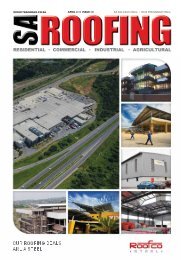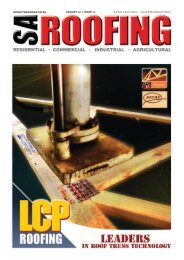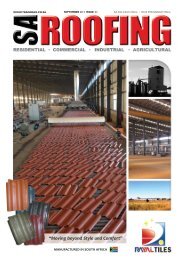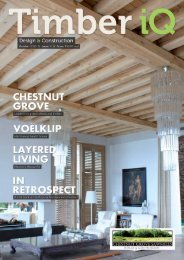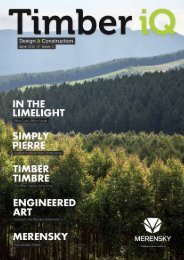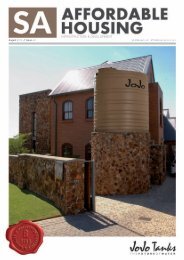project - Trademax Publications
project - Trademax Publications
project - Trademax Publications
Create successful ePaper yourself
Turn your PDF publications into a flip-book with our unique Google optimized e-Paper software.
PROJECT<br />
The house faces the appropriate direction for ensuring bedrooms can benefit from<br />
sunlight, while the living room faces north<br />
the durability of the home,” explains Hans Ittmann, Executive<br />
Director of CSIR Built Environment.<br />
Some contractors in the low-income market do not lay<br />
foundations to standard. To eliminate cracked walls resulting<br />
from sub-standard foundations, a CSIR technology developed<br />
for roads was adapted to form the foundation slab of the house.<br />
“Local labour can be used to construct such foundations, which<br />
is based on ultra-thin, continuously-reinforced concrete<br />
technology,” says Ittmann.<br />
“We used a modular, design-to-fit approach similar to a Lego<br />
set where pieces have to fit together correctly to form the bigger<br />
unit,” explains Llewellyn van Wyk, senior researcher at the<br />
CSIR. One big difference to current low-income houses is the<br />
design of the bathroom and kitchen area, and the use of a<br />
waste outlet manifold that is pre-manufactured, quality-tested<br />
and installed on site. This reduces the extent of the plumbing<br />
installation substantially while ensuring that the installation is<br />
done to the required standard.<br />
“Standard low-income houses have no<br />
ceilings and thus no insulation, which<br />
results in incredible variations in<br />
temperatures,” says Van Wyk.<br />
The thermal performance of the roof was<br />
improved dramatically with the addition<br />
of an insulation material that doubles up<br />
as a ceiling. The house faces the<br />
appropriate direction for ensuring<br />
bedrooms can benefit from sunlight, while<br />
the living room faces north.<br />
The CSIR low-income housing initiative is<br />
a research <strong>project</strong>-in-progress. The most<br />
recent additions include a solar-powered<br />
geyser on top of the roof and a photovoltaic<br />
panel above the front door for<br />
powering lights inside the house. “CSIR<br />
researchers will continue to pursue<br />
improved performance and sustainability<br />
for the low-income housing sector to<br />
impact on the quality of life of<br />
communities,” concludes Sibisi.<br />
Incorporating most components of the CSIR-developed lowincome<br />
house, local authorities will have demonstration units<br />
constructed in the Buffalo City Municipality in the Eastern Cape<br />
and at Kleinmond in the Western Cape.<br />
The use of a waste outlet manifold that is premanufactured,<br />
quality tested and installed on site<br />
reduces the extent of the plumbing installation<br />
substantially<br />
37<br />
SA Affordable Housing November/December 2009




